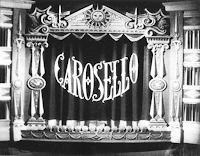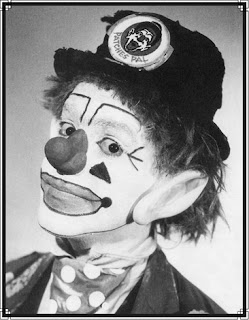
Tuesday, August 26, 2008
Creminelli Salami

Saturday, August 23, 2008
Carosello – Italian Ads


Con meTu puoi fumare la tua pipa quando vuoiPerché mi piaci molto di piùE sei così romanticoFumo blu, fumo bluUna nuvola e dentro tuE poi, e poiSe un uomo sa di fumoMa sì, ma sìÈ veramente un uomoIo ti amerò finché vorraiProprio perché sei così
With meYou can smoke your pipe when you wantBecause I like you even moreAnd you are so romanticBlue smoke, blue smokeA cloud with you insideBesidesA man who smells like smoke (or knows how to smoke)Ah yesIs truly a manI'll love you as long as you wantBecause you are like that
BarillaCon BarillaCapolavoro di pastaPotete fare ogni giornoUn capolavoro di buona cucinaB come buona cucinaB come BarillaCon BarillaRivelate la gran cuoca che c'è in voiÉ così davveroC'e una gran cuoca in voiE Barilla la rivela
BarillaWith BarillaMasterpiece of pastaEvery day you can makeA masterpiece of beautiful cookingB for good cookingB for BarillaWith BarillaReveal the great cook in youThat's a factThere a great cook in youAnd Barilla reveals it
Phelps, Bigfoot, and Presidentialism

What do these three things have in common? Perhaps nothing really, but in my early-morning, crow-cawing-pierced, groggy Saturday morning mind they all united in a common theme: fascination with the “top dog” to the exclusion of everything else. I know, sour grapes in regards to Phelps and his medals, but it did not sit well with me the response and media coverage of his effort. It seemed so over-the-top to the exclusion of all other possible stories. Now a pending book. Then throw in another Bigfoot hoax. People just want to believe there is a “big guy”, a “top dog” out there waiting to be discovered. The "discovery" was complete with an official news conference put on by the two car salesmen who made the find. Psst, hey reporters, you know that Bigfoot doesn’t exist and besides (exclusion theme) we have so many other serious problems (war, poverty, etc.) to deal with? Finally, there is the vice president choice for the two presidential candidates. Does it matter? Not really according to many and it displays our endless fascination with the “top dog”. In an interesting piece called The Conquest of Presidentialism, presidentialism as defined by Vanderbilt professor Dana Nelson is: our paternalistic view that presidents are godlike saviors—and therefore democracy’s only important figures. In the same piece there is a reference to a quote by Alexis de Tocqueville (1805 – 1859), a French historian who made some astute observations about 19th century American democracy that are still relevant today, which I’ll repeat here. The quote refers to our capability to select leaders. True or false?
“It is in vain to summon a people, which has been rendered so dependent on the central power, to choose from time to time the representatives of that power; this rare and brief exercise of their free choice, however important it may be, will not prevent them from gradually losing the faculties of thinking, feeling, and acting for themselves, and thus gradually falling below the level of humanity.” (Democracy in America, Volume 2)
Tuesday, August 19, 2008
Prompt if device unused for…
What did I expect? A new device running a Windows OS (on Samsung BlackJack II -previous post) and with a day or so I need to tweak the registry. To tweak the registry I used CeRegEdit. Why? Because I connected to an Exchange Server in the sky and it squirted some security policy changes down to my phone so that it would not let me select “Prompt if device unused for” checkbox. This meant I had to enter a complicated password every time I unlocked. I’m fine as long as I was talking to Exchange, but after I discontinued that partnership/connection I should at least have the phone go back to the way it was. But no. I followed the advice in this post and it worked great. Basically, connect to the registry of the device and change the HKLM/Security/Policies/Policies/00001023 to 1. Ironically, I think having a password is good, just that I want the flexibility to determine when I want it.
The password settings in Windows Mobile located under Start\Settings\Security\Device Lock.
Monday, August 18, 2008
To All the Watches We Loved Before: Disco Tex and the Sex-O-Lettes

Saturday, August 16, 2008
Argh, They Hooked Us Again

Why oh why could we just not keep our old phones and save a bundle of money? No, instead we both have fancy new phones (the same), just different colors. (We get the same phones because one of us is hardware-challenged and relies on the other for instruction.) The phone: the Samsung BlackJack II. The screen is a little small-ish and the headphones and the USB are not standard. Also, can’t use my old SIM storage card because it takes a different sized one. So far, the jury is out. We are on a family plan which is suppose to save you money, but with the features we added is actually costing us more.
J.P. Patches Lands in Fremont

Last night we were eating at Blue Moon Burgers in the technology-canal-alley in Fremont (Adobe, Getty, Google, etc. reside there) when we discovered a new statue is to be unveiled in this corporate-park-lite (sorry, it’s not up to Fremont-funky yet). The new statues are just a couple of steps away from the (in)famous Waiting for the Interurban and a bit further from the Fremont Troll, Lenin, and the Rocket.
Friday, August 15, 2008
Sprezzatura – 50 Ways Italian Genius Shaped the World

The term “sprezzatura” may not be familiar to everyone. The book Sprezzatura* – 50 Ways Italian Genius Shaped the Word even footnotes the definition on the front cover: * “the art of effortless mastery”. Of course our faithful 6 Travelmarx readers may recall that we have already mentioned this in previous posts Baby You’ve Got Some Sprezzatura and Child Sprezzatura. In those posts we defined it as a certain nonchalance that makes what one does seem uncontrived and effortless.
Saturday, August 9, 2008
What’s the Difference Between the Italian and Mexican Flag?


Recently, we hung an Italian-flag windsock on our deck as a prop for an upcoming party and realized that the colors of Italian flag looked a lot like the Mexican flag on first glance. (A neighbor dutifully noted the windsock and commented that she was surprised because we were not “windsock” people.)
So what are the differences between the Italian and Mexican flags? The Italian flag is a vertical tricolor (in Italian Il Tricolore) of green, white, and red. The Mexican flag on first glance is the same except the there is a coat of arms in the center white stripe. However, there are a couple of subtle differences. The Italian flag uses lighter shades of green and red and the Italian flag has an aspect ratio (width:height) of 3:2 while the Mexican flag is 7:4.
The meaning of the colors for the Mexican flag likewise is not fixed, but can be taken to mean roughly: green = hope, white = purity and red = blood of national heroes (as pointed out by several comments below, in particular the comment August 26, 2017 at 5:53 PM).


If you are into more similarities, a few pointed out in the comments, there are also these:
- Monaco / Indonesia flag similarity
- Romania / Chad flag similarity
- Mali / Senegal flag similarity (very similar are Guinea and Cameroon)
- Netherlands / Luxembourg flag similarity
- New Zealand / Australia flag similarity
- Slovenia / Slovakia / Russia flag similarity
- Ecuador / Columbia Venezuela flag similarity
Biking To Work (Sort Of)

So I’m only biking about 8 miles a day, but it’s something. It makes the 2 hour (total) commute a little bit more palatable knowing that for half of it I’m getting a little exercise. I bike from Fremont to Montlake and then take a bus to the east side. I hope it doesn’t rain for the next year.
Friday, August 8, 2008
I Can’t Believe I’m Working (Again)
Week two of a contract position at a large software firm on the east side. Uh, which would that be? So far so good. Good team, good people, interesting work. The weirdest part is seeing faces I recognize from years ago on past assignments. This if followed by the inevitable search through the address book to see what fabulous title they have now and you don’t, then a sigh, and back to work.
Sunday, August 3, 2008
TravelMarx Music Recommendations: Watershed and Blame Sally


The first recommendation is K.D. Lang’s Watershed. By the second listen we were hooked. It’s laid back, restrained. The songs are deceptively simple and they are all similar in pace and delivery. This can have the effect of making the songs seem to blur together. For me the effect is dreamy – to each his own.
The second recommendation is Blame Sally’s Blame Sally. On the first play I was hooked. It’s the album I put on at work to pull me through the day. The opening strains of the wistful first track, Birds Fly South, let me know I can get through the rest of the day reasonably sane.
Saturday, August 2, 2008
I Can’t Believe I’m Knitting


Knit 2, Purl 2. My new mantra. Hello knitting. We were taught by Noni. I’m making a scarf (how original) and Mark is making a pot holder that is knitted and then shrunk via washing (called felting). Knitting is actually very computer-like. The two knit stitches, knit and purl, are like ones and zeros. You can assemble them in endless patterns. A knit stitch on one side is a purl stitch on the other.
